Regolith-Hosted Rare Earth Element Mineralization in the Esperance Region, Western Australia: Major Characteristics and Potential Controls
Abstract
:1. Introduction
2. Materials and Methods
3. Results
3.1. Geological Setting
3.1.1. Regional Geology
- Archean (c. 2800–2660 Ma) tonalitic to monzogranitic Munglinup Gneiss of the Northern Foreland. The granulite facies Munglinup Gneiss is a higher metamorphic grade component of the Northern Foreland exhumed from deeper crust levels [7]. The Munglinup Gneiss comprises amphibolite to granulite grade orthogneisses, interlayered with lenses of metamorphosed mafic rocks, with minor banded chert, amphibolitic schist, and metamorphosed ultramafic rocks, which are interpreted as remnants of Archean greenstone sequences [7]. The most abundant phase in the Munglinup Gneiss is a leucocratic, mostly homogeneous, banded tonalitic to monzogranitic gneiss (Figure 2a) of the weakly peraluminous composition.
- Paleoproterozoic (c. 1690–1660 Ma) metagranitic Dalyup and Coramup Gneisses of the Biranup Zone. The Dalyup Gneiss is the main component of the Biranup Zone; it is composed of heterogeneous, usually intensely deformed and metamorphosed up to granulite facies granitic rocks and less abundant mafic rocks. Rock types include granodioritic, monzogranitic, and syenogranitic gneisses, orthopyroxene-bearing granitic gneiss, quartz–magnetite gneiss, mafic gneiss, and amphibolite [28,29,30]. Unlike the Dalyup Gneiss, the Coramup Gneiss contains both orthogneisses and paragneisses. Rock types include granitic to granodioritic gneiss, tonalitic gneiss, lenses and boudins of metamorphosed mafic rocks, quartz-rich psammite, and minor migmatitic metapelite [31,32]. At Newmont (Salazar project), especially in the western part, REE mineralization also develops over elongated para-amphibolite bodies of plagioclase–hornblende–biotite composition, although REEs seem to have originated from contact zones with surrounding granitic gneisses [18].
- Mesoproterozoic (c. 1330–1280 Ma) metamorphosed monzogranites and granodiorites of the Recherche Supersuite dominate the Nornalup Zone, masking much of the original Paleoproterozoic (c. 1800–1650 Ma) basement. The granitoids comprise foliated metagranites or gneisses with syenogranitic, monzogranitic, and granodioritic compositions. Most of the Gora Hill suite granitoids are related to the A-type granites (Figure 2b). Weakly peraluminous granites of the Southern Hills suite are assigned to the I-, S- or M-type granites. Most of these rocks appear to be mingled with a mafic component, generally present as enclaves of various sizes.
- Mesoproterozoic (c. 1140 Ma) granites, monzogranites, and syenogranites of the Esperance Supersuite. These granitoids represent the late-stage magmatism of the Albany–Fraser Orogeny, at c. 1140 Ma [7,29,33]. Rocks of the Esperance Supersuite are relatively undeformed and of low metamorphic grade [34]. The A-type, weakly peraluminous to metaluminous monzogranites of the Booanya Suite assigned by chemical composition (Figure 2) within the Esperance Supersuite occur within a 90 km wide, northeasterly trending, generally magnetic belt in the eastern Nornalup Zone [26]. Weakly peraluminous granites of the Truslove suite are assigned to the I-, S-, or M-type granites.

3.1.2. Geomorphology and Regolith
3.2. Regolith REE Mineralization
3.3. Rare Earth Element Speciation

4. Discussion
4.1. Factors Controlling Regolith-Hosted REE Mineralization
4.2. Potential Mineralization Controls in the Esperance Region
4.3. Climate Evolution and Hydrogeochemistry
- Glacial erosion during the Early Permian followed by Palaeozoic and Mesozoic weathering that eroded many of the pre-existing geomorphologic features;
- Humid and sub-tropical conditions in the Late Cretaceous that promoted intense chemical weathering;
- Sea-level changes in the Late Cretaceous–Mid-Eocene resulting in erosion and active sedimentary processes that reshaped the landscape;
- Intense weathering under humid tropical-sub tropical conditions during the Paleocene and Eocene;
- Climate conditions changed to semi-arid and arid in the Neogene and Quaternary.
4.4. REE Mobility in Acid Groundwaters
4.5. An Integrated Genetic Model and Practical Implications
5. Conclusions
Author Contributions
Funding
Data Availability Statement
Acknowledgments
Conflicts of Interest
References
- Lusty, P.A.J.; Shaw, R.A.; Gunn, A.G.; Idoine, N.E. UK Criticality Assessment of Technology Critical Minerals and Metals; British Geological Survey Commissioned Report 2021, CR/21/120; British Geological Survey: Nottinghamshire, UK, 2021; 76p. [Google Scholar]
- Department of Industry, Science, Energy and Resources. Critical Minerals Strategy 2023–2030. Available online: https://www.industry.gov.au/sites/default/files/2023-06/critical-minerals-strategy-2023-2030.pdf (accessed on 19 July 2024).
- IEA (International Energy Agency). The Role of Critical Minerals in Clean Energy Transitions. Available online: https://www.iea.org/reports/the-role-of-critical-minerals-in-clean-energy-transitions (accessed on 19 July 2024).
- Liu, S.-L.; Fan, H.-R.; Liu, X.; Meng, J.; Butcher, A.R.; Yann, L.; Yang, K.-F.; Li, X.-C. Global rare earth elements projects: New developments and supply chains. Ore Geol. Rev. 2023, 157, 105428. [Google Scholar] [CrossRef]
- Uren, D. Breaking China’s Near Monopoly on Rare Earths Will Be Easier Said than Done. The Strategist, 8 November 2022. Available online: https://www.aspistrategist.org.au/breaking-chinas-near-monopoly-on-rare-earths-will-be-easier-said-than-done/ (accessed on 19 July 2024).
- King, H.M. REE—Rare Earth Elements and Their Uses. 2023. Available online: https://geology.com/articles/rare-earth-elements/#:~:text=rare%20earth%20metals.-,Uses%20of%20Rare%20Earth%20Elements,fluorescent%20lighting%20and%20much%20more (accessed on 19 July 2024).
- Spaggiari, C.V.; Bodorkos, S.; Barquero-Molina, M.; Tyler, I.M.; Wingate, M.T.D. Interpreted Bedrock Geology of the South Yilgarn and Central Albany–Fraser Orogen; Record 2009/10; Geological Survey of Western Australia: East Perth, Australia, 2009; 84p. [Google Scholar]
- Heavy Rare Earths Ltd. Five-Fold Increase in Mineral Resources to 159 Mt @ 870 ppm Total Rare Earth Oxides at Cowalinya Project in Western Australia; Australian Stock Exchange Announcement; Heavy Rare Earths Ltd.: Perth, Australia, 2023. [Google Scholar]
- West Cobar Metals. Salazar Clay-REE Resource Quadruples to 190 Mt @ 1172 ppm TREO at a 600 ppm Cut-Off; Australian Stock Exchange Announcement; West Cobar Metals: Perth, Australia, 2023. [Google Scholar]
- OD6 Metals. Splinter Rock Rare Earth Project Maiden Mineral Resource Estimate 344 Mt @ 1308 ppm TREO at a 1000 ppm Cut Off; Australian Stock Exchange Announcement; OD6 Metals: Perth, Australia, 2023. [Google Scholar]
- Meeka Metals. 98 Mt @ 890 ppm TREO—Initial Independent High-Grade Rare Earth Mineral Resource at Circle Valley; Australian Stock Exchange Announcement; Meeka Metals: Perth, Australia, 2023. [Google Scholar]
- Sanematsu, K.; Watanabe, Y. Characteristics and genesis of ion-adsorption type deposits. Rev. Econ. Geol. 2016, 18, 55–79. [Google Scholar]
- Rogers, K.A. Esperance Splinter project, exploration licences E63/1415. In Annual Technical Report for the Period 12/01/2011 to 11/01/2012; WAMEX A093149; Salazar Gold Pty Ltd.: Perth, Australia, 2012; 59p. [Google Scholar]
- Heavy Rare Earths Limited Prospectus; Australian Stock Exchange Announcement; Heavy Rare Earths Limited: Perth, Australia, 2022.
- Collins, T. Understanding the Geochemistry and Mineralogy of Regolith Hosted REE Mineralisation. Bachelor’s Thesis, The University of Western Australia, Crawley, Australia, 2014. [Google Scholar]
- Mount Ridley Mines. Excellent Screen Beneficiation Test Results Lift REE Grades by up to 202% at the Mount Ridley REE Project; Australian Stock Exchange Announcement; Mount Ridley Mines: Perth, Australia, 2023. [Google Scholar]
- OD6 Metals. Very High Magnet Rare Earth Recoveries Achieved at Splinter Rock Project; Australian Stock Exchange Announcement; OD6 Metals: Perth, Australia, 2023. [Google Scholar]
- West Cobar Metals. Excellent Rare Earth Metallurgical Recoveries Achieved at Salazar; Australian Stock Exchange Announcement; West Cobar Metals: Perth, Australia, 2023. [Google Scholar]
- Crook, D.J.; Brand, N.W. Clay-hosted rare earth element mineralisation in the Esperance district of Western Australia. In Proceedings of the CRITCON, Adelaide, Australia, 22–26 May 2023. [Google Scholar]
- Trench, A.; Zhang, L.; Groves, D.I.; Crook, D.; Brand, N.W. Australian critical metal exploration for analogues of Chinese ionic-clay REE deposits. Geosyst. Geoenviron. 2024, 100293. [Google Scholar] [CrossRef]
- Shuman, L.M. Fractionation method for soil microelements. Soil Sci. 1985, 140, 11–22. [Google Scholar] [CrossRef]
- Hall, G.E.M.; Gauthier, G.; Pelchat, J.-C.; Pelchat, P.; Vaive, J.E. Application of a sequential extraction scheme to ten geological certified reference materials for the determination of 20 elements. J. Anal. At. Spectrom. 1996, 11, 787–796. [Google Scholar]
- Du, X.; Rate, A.W.; Gee, M.A.M. Particle size fractionation and chemical speciation of REE in a lateritic weathering profile in Western Australia. Explore 2012, 157, 1–14. [Google Scholar]
- Taylor, S.R.; McLennan, S.M. The Continental Crust: Its Composition and Evolution; Blackwell: Oxford, UK, 1985; 312p. [Google Scholar]
- Spaggiari, C.V.; Kirkland, C.L.; Pawley, M.J.; Smithies, R.H.; Wingate, M.T.D.; Doyle, M.G.; Blenkinsop, T.G.; Clark, C.; Oorschot, C.W.; Fox, L.J.; et al. The Geology of the East Albany–Fraser Orogen—A Field Guide; Record 2011/23; Geological Survey of Western Australia: East Perth, Australia, 2011; 97p. [Google Scholar]
- Smithies, R.H.; Spaggiari, C.V.; Kirkland, C.L. Building the Crust of the Albany–Fraser Orogen: Constraints from Granite Geochemistry; Report 150; Geological Survey of Western Australia: East Perth, Australia, 2015; 49p. [Google Scholar]
- Myers, J.S. The Fraser Complex: A major layered intrusion in Western Australia. In Professional Papers for 1983; Report 14; Geological Survey of Western Australia: East Perth, Australia, 1985; pp. 57–66. [Google Scholar]
- Beeson, J.; Delor, C.P.; Harris, L.B. A structural and metamorphic traverse across the Albany Mobile Belt, Western Australia. Precambr. Res. 1988, 40–41, 117–136. [Google Scholar] [CrossRef]
- Nelson, D.R.; Myers, J.S.; Nutman, A.P. Chronology and evolution of the Middle Proterozoic Albany–Fraser Orogen, Western Australia. Aust. J. Earth Sci. 1995, 42, 481–495. [Google Scholar] [CrossRef]
- Geological Survey of Western Australia. South Yilgarn Geological Exploration Package; Record 2007/13; Geological Survey of Western Australia: East Perth, Australia, 2007. [Google Scholar]
- Bodorkos, S.; Clark, D.J. Evolution of a crustal-scale transpressive shear zone in the Albany Fraser Orogen, SW Australia: 1. P–T conditions of Mesoproterozoic metamorphism in the Coramup Gneiss. J. Metamorph. Geol. 2004, 22, 691–711. [Google Scholar] [CrossRef]
- Bodorkos, S.; Clark, D.J. Evolution of a crustal-scale transpressive shear zone in the Albany Fraser Orogen, SW Australia: 2. Tectonic history of the Coramup Gneiss and a kinematic framework for Mesoproterozoic collision of the West Australian and Mawson cratons. J. Metamorph. Geol. 2004, 22, 713–731. [Google Scholar] [CrossRef]
- Clark, D.J.; Hensen, B.J.; Kinny, P.D. Geochronological constraints for a two-stage history of the Albany–Fraser Orogen, Western Australia. Precambrian Res. 2000, 102, 155–183. [Google Scholar] [CrossRef]
- Myers, J.S. Geology of the Esperance 1:1 000 000 Sheet; 1:1 000 000 Geological Series Explanatory Notes; Geological Survey of Western Australia: East Perth, Australia, 1995; 10p. [Google Scholar]
- Middlemost, E.A.K. Naming Materials in the Magma/Igneous Rock System. Earth-Sci. Rev. 1994, 37, 215–244. [Google Scholar] [CrossRef]
- Whalen, J.B.; Currie, K.L.; Chappell, B.W. A-type granites: Geochemical characteristics, discrimination and petrogenesis. Contrib. Mineral. Petrol. 1987, 95, 407–419. [Google Scholar] [CrossRef]
- van de Graaff, W.J.E.; Crowe, R.W.A.; Bunting, J.A.; Jackson, M.J. Relict Early Cainozoic drainages in arid Western Australia. Z. Geomorphol. 1977, 21, 379–400. [Google Scholar] [CrossRef]
- Veevers, J.J. (Ed.) Phanerozoic Earth History of Australia; Clarendon Press: Oxford, UK, 1984. [Google Scholar]
- Gammon, P.R.; James, N.P.; Clarke, J.D.A.; Bone, Y. Sedimentology and lithostratigraphy of Upper Eocene sponge-rich sediments, southern Western Australia. Aust. J. Earth Sci. 2000, 47, 1087–1103. [Google Scholar] [CrossRef]
- Daniels, J.L. Palaeogeographic development of Western Australia (Precambrian). Geol. Surv. West. Aust. Mem. 1975, 2, 437–450. [Google Scholar]
- Playford, P.E.; Cope, R.N.; Cockbain, A.E. Palaeogeographic development of Western Australia—Phanerozoic. Geol. Surv. West. Aust. Mem. 1975, 2, 451–460. [Google Scholar]
- Butt, C.R.M. Major uranium provinces: Yilgarn Block and Gascoyne Province. In Recognition of Uranium Provinces; International Atomic Energy Commission: Vienna, Austria, 1989; pp. 273–304. [Google Scholar]
- Anand, R.R.; Paine, M. Regolith geology of the Yilgarn Craton, Western Australia: Implications for exploration. Aust. J. Earth Sci. 2002, 49, 3–162. [Google Scholar] [CrossRef]
- Bunting, J.A.; Van de Graaff, W.J.E.; Jackson, M.L. Palaeogeography of the Eastern Goldfields, Gibson Desert and Great Victoria Desert. Geol. Surv. West. Aust. Annu. Rep. 1973, 1974, 45–50. [Google Scholar]
- Morgan, K.H.; Peers, R. Esperance—Mondrain Island Geological Sheet, SI51-6 & SI51-10; 1:250 000 Geological Series Explanatory Notes; Geological Survey of Western Australia: East Perth, Australia, 1973. [Google Scholar]
- Cope, R.N. Tertiary epeirogeny in the southern part of Western Australia. Geol. Surv. West. Aust. Annu. Rep. 1974, 1975, 40–46. [Google Scholar]
- de Broekert, P.; Sandiford, M. Buried inset-valleys in the Eastern Yilgarn Craton, Western Australia: Geomorphology, age, and allogenic control. J. Geol. 2005, 113, 471–493. [Google Scholar] [CrossRef]
- Finkl, C.W. Stripped (etched) landsurfaces in southern Western Australia. Aust. Geogr. Stud. 1979, 17, 33–52. [Google Scholar] [CrossRef]
- Anand, R.R.; Butt, C.R.M. A guide for mineral exploration through the regolith in the Yilgarn Craton, Western Australia. J. Geol. Soc. Aust. 2010, 57, 1015–1114. [Google Scholar] [CrossRef]
- Lillicrap, A.M.; Biermann, V.; George, R.J.; Gray, D.J.; Oldham, C.E. The distribution and origins of extremely acidic saline groundwaters in the south of Western Australia—Groundwater and digital mapping datasets provide new insights. J. Hydrol. 2018, 556, 717–731. [Google Scholar] [CrossRef]
- González-Álvarez, I.; Anand, R.R.; Hough, R.; Salama, W.; Laukamp, C.; Sweetapple, M.T.; Ley-Cooper, Y.; Sonntag, I.; Lintern, M.; Abdat, T.; et al. Greenfields Geochemical Exploration in a Regolith-Dominated Terrain: The Albany–Fraser Orogen/Yilgarn Craton Margin; Report 144; Geological Survey of Western Australia: East Perth, Australia, 2014; 213p. [Google Scholar]
- Laukamp, C.; Salama, W.; González-Álvarez, I. Proximal and remote spectroscopic characterisation of regolith in the Albany–Fraser Orogen (Western Australia). Ore Geol. Rev. 2016, 73, 540–554. [Google Scholar] [CrossRef]
- Heavy Rare Earths Ltd. Metallurgical Program Delivers Two-Fold Grade Increase and Up to 91.3% Extraction of Magnet Rare Earths; Australian Stock Exchange Announcement; Heavy Rare Earths Ltd.: Perth, Australia, 2023. [Google Scholar]
- OD6 Metals. The REE Potential of the Esperance District. ANU REE Conference Presentation, 16 November 2022. Available online: https://www.od6metals.com.au/wp-content/uploads/2024/05/61180850-2.pdf (accessed on 19 July 2024).
- Rogers, K.A. Esperance project, exploration licences E63/1415, E63/1469, E63/1496, E69/2783, E69/2784 and E69/2944. In Combined Annual Technical Report for the Period 6 May 2014 to 5 May 2015; WAMEX A106234; Salazar Gold Pty Ltd.: Perth, Australia, 2018; 177p. [Google Scholar]
- OD6 Metals. Standout Grades, Thickness and Extent of REE Mineralisation Confirmed at Centre Prospect; Australian Stock Exchange Announcement; OD6 Metals: Perth, Australia, 2023. [Google Scholar]
- Meeka Metals. 12m @ 4276 ppm TREO—Further High-Grade Infill and Extensional Assays Support Initial Circle Valley REE Mineral Resource; Australian Stock Exchange Announcement; Meeka Metals: Perth, Australia, 2023; 276p. [Google Scholar]
- Mount Ridley Mines. Coincident High-Grade Rare Earth Elements and Geophysical Anomalies at Mia Prospect; Australian Stock Exchange Announcement; Mount Ridley Mines: Perth, Australia, 2023. [Google Scholar]
- Dundas Minerals. Exploration Update: Rare Earth Elements Exploration Program; Australian Stock Exchange Announcement; Dundas Minerals: Perth, Australia, 2023. [Google Scholar]
- Rogers, K.A. Esperance project, exploration licences E63/1415, E63/1469, E63/1496, E69/2783, E69/278, E69/2944 and E69/301. In Combined Annual Technical Report for the Period 6 May 2012 to 5 May 2013; WAMEX A098490; Salazar Gold Pty Ltd.: Perth, Australia, 2013; 102p. [Google Scholar]
- Li, Y.H.M.; Zhao, W.W.; Zhou, M.F. Nature of parent rocks, mineralization styles and ore genesis of regolith-hosted REE deposits in South China: An integrated genetic model. J. Asian Earth Sci. 2017, 148, 65–95. [Google Scholar] [CrossRef]
- Bao, Z.; Zhao, Z. Geochemistry of mineralization with exchangeable REY in the weathering crusts of granitic rocks in South China. Ore. Geol. Rev. 2008, 33, 519–535. [Google Scholar] [CrossRef]
- Braun, J.-J.; Pagel, M.; Muller, J.-P.; Bilong, P.; Michard, A.; Guillet, B. Cerium anomalies in lateritic profiles. Geochim. Cosmochim. Acta 1990, 54, 781–795. [Google Scholar] [CrossRef]
- Chi, R.; Tian, J. Review of weathered crust rare earth ores. J. Chinese Rare Earth Soc. 2007, 25, 641–650, (In Chinese with English abstract). [Google Scholar]
- Chi, R.; Tian, J.; Luo, X.; Xu, Z.; He, Z. The basic research on the weathered crust elution-deposited rare earth ores. Nonferrous Met. Sci. Eng. 2012, 3, 1–13, (In Chinese with English abstract). [Google Scholar]
- Sanematsu, K.; Kon, Y.; Imai, A.; Watanabe, K.; Watanabe, Y. Geochemical and mineralogical characteristics of ion-adsorption type REE mineralization in Phuket, Thailand. Miner. Deposita 2013, 48, 437–451. [Google Scholar] [CrossRef]
- Townend, R.; Townend, D. Townend mineralogy laboratory report 5 January 2016. In Esperance Project, Exploration Licences E63/1415, E63/1469, E63/1496, E63/1749, E69/2783, E69/2784 and E69/2944; Combined Annual Technical Report for the Period 6 May 2015 to 5 May 2016; WAMEX A109432; Salazar Gold Pty Ltd.: Perth, Australia, 2018; 135p. [Google Scholar]
- Rogers, K.A. Esperance Project, Exploration Licences E69/2783 and E69/2784; Final Surrender Technical Report for the Period 6 May 2011 to 5 April 2018; WAMEX A117039; Salazar Gold Pty Ltd.: Perth, Australia, 2018; 62p. [Google Scholar]
- Foley, N.; Ayuso, R. REE enrichment in granite-derived regolith deposits of the Southeastern United States: Prospective source rocks and accumulation processes. In Proceedings of the Symposium on Strategic and Critical Materials Proceedings, Victoria, BC, Canada, 13–14 November 2015; Simandl, G.J., Neetz, M., Eds.; British Columbia Geological Survey Paper 2015-3. British Columbia Ministry of Energy and Mines: Victoria, BC, Canada, 2015; pp. 131–138. [Google Scholar]
- Townend, R. Roger Townend and Associates Consulting Mineralogists report 28/10/2011. In Esperance Project, Exploration Licences E63/1415, E63/1469, E63/1496, E63/1749, E69/2783, E69/2784, E69/2944 and E69/3010; Combined Annual Technical Report for the Period 6/5/2012 to 5/4/2013; WAMEX A098490; Salazar Gold Pty Ltd.: Perth, Australia, 2013; 102p. [Google Scholar]
- Townend, R.; Townend, D. Townend Mineralogy Laboratory Report RT23634, Perth, Australia, 2014; 29p.
- Chi, R.; Tian, J. Weathered Crust Elution-Deposited Rare Earth Ores; Nova Science Publishers: New York, NY, USA, 2009; 288p. [Google Scholar]
- Denys, A.; Janots, E.; Auzende, A.L.; Lanson, M.; Findling, N.; Trcera, N. Evaluation of selectivity of sequential extraction procedure applied to REE speciation in laterite. Chem. Geol. 2021, 559, 119954. [Google Scholar] [CrossRef]
- Fu, W.; Li, X.T.; Feng, Y.Y.; Feng, M.; Peng, Z.; Yu, H.X.; Lin, H. Chemical weathering of S-type granite and formation of rare earth element (REE)-rich regolith in South China: Critical control of lithology. Chem. Geol. 2019, 520, 33–51. [Google Scholar] [CrossRef]
- Li, M.Y.H.; Zhou, M.F.; Williams-Jones, A.E. The genesis of regolith-hosted heavy rare earth element deposits: Insights from the world-class Zudong deposit in Jiangxi Province, South China. Econ. Geol. 2019, 114, 541–568. [Google Scholar] [CrossRef]
- Sanematsu, K.; Kon, Y. Geochemical characteristics determined by multiple extraction from ion- adsorption type REE ores in Dingnan County of Jiangxi Province, South China. Bull. Geol. Surv. Japan 2013, 64, 313–330. [Google Scholar] [CrossRef]
- Wenzel, W.W.; Kirchbaumer, N.; Prohaska, T.; Stingeder, G.; Lombi, E.; Adriano, D.C. Arsenic fractionation in soils using an improved sequential extraction procedure. Anal. Chim. Acta. 2001, 436, 309–323. [Google Scholar] [CrossRef]
- Marquis, E. Rare Earth Element (REE) Mobility in Alkaline Igneous Rocks and the Potential Impact on the Formation of Ion Adsorption Type REE Ores of the Ambohimirahavavy Alkaline Complex. Ph.D. Thesis, The University of Brighton, Brighton, UK, 19 September 2019. [Google Scholar]
- Sanematsu, K.; Ejima, T.; Kon, Y.; Manaka, T.; Zaw, K.; Morita, S.; Seo, Y. Fractionation of rare-earth elements during magmatic differentiation and weathering of calc-alkaline granites in southern Myanmar. Mineral. Mag. 2016, 80, 77–102. [Google Scholar] [CrossRef]
- Li, M.Y.H.; Kwong, H.T.; Williams-Jones, A.E.; Zhou, M.-F. The thermodynamics of rare earth element liberation, mobilization and supergene enrichment during groundwater-regolith interaction. Geochim. Cosmochim. Acta 2022, 330, 258–277. [Google Scholar] [CrossRef]
- Pinto-Ward, C. Controls on the Enrichment of the Serra Verde Rare Earth Deposit, Brazil. Ph.D. Thesis, Imperial College, London, UK, 2017. [Google Scholar]
- Marker, A.; de Oliveira, J.J. Climatic and morphological control of rare earth distribution in weathering mantles on alkaline rocks. Catena 1994, 21, 179–193. [Google Scholar] [CrossRef]
- Li, M.Y.H.; Zhou, M.-F.; Williams-Jones, A.E. Controls on the dynamics of rare earth elements during sub-tropical hillslope processes and formation of regolith-hosted deposits. Econ. Geol. 2020, 115, 1097–1118. [Google Scholar] [CrossRef]
- Wang, M.; Li, M.Y.H.; Zhou, M.-F.; Zhou, J.-X.; Sun, G.; Xiao, S.; Liu, F.-X.; Zhang, Z.-J. Enrichment of rare earth elements in weathered alkaline igneous systems: Insights from the Puxiong regolith-hosted REE deposit, SW China. Econ. Geol. 2024, 119, 161–187. [Google Scholar] [CrossRef]
- Freyssinet, P.; Butt, C.R.M.; Morris, R.C.; Piantone, P. Ore-forming processes related to lateritic weathering. In Economic Geology: One Hundredth Anniversary Volume; Society of Economic Geologists, Inc.: Littleton, CO, USA, 2005; pp. 681–722. [Google Scholar] [CrossRef]
- Samama, J.-C. Ore Fields and Continental Weathering; Van Nostrand Reinhold Company: New York, NY, USA, 1986. [Google Scholar]
- González-Álvarez, I.; Salama, W.; Anand, R.R. Sea-level changes and buried islands in a complex coastal palaeolandscape in the South of Western Australia: Implications for greenfield mineral exploration. Ore Geol. Res. 2016, 73, 475–499. [Google Scholar] [CrossRef]
- Bird, M.I.; Chivas, A.R. Stable-isotope geochronology of the Australian regolith. Geochim. Cosmochim. Acta 1989, 53, 3239–3256. [Google Scholar] [CrossRef]
- Clarke, J.D.A. Evolution of the Lefroy and Cowan palaeodrainage channels, Western Australia. Aust. J. Earth Sci. 1994, 41, 55–68. [Google Scholar] [CrossRef]
- Dammer, D.; McDougall, I.; Chivas, A.R. Timing of weathering-induced alteration of manganese deposits in Western Australia: Evidence from K/Ar and 40Ar/39Ar dating. Econ. Geol. 1999, 94, 87–108. [Google Scholar] [CrossRef]
- Long, D.T.; Lyons, W.B.; Hines, M.E. Influence of hydrogeology, microbiology and landscape history on the geochemistry of acid hypersaline waters, N.W.Victoria. Appl. Geochem. 2009, 24, 285–296. [Google Scholar] [CrossRef]
- Bowen, B.B.; Benison, K.C. Geochemical characteristics of naturally acid and alkaline saline lakes in southern Western Australia. Appl. Geochem. 2009, 24, 268–284. [Google Scholar] [CrossRef]
- Gray, D.J. Hydrogeochemistry in the Yilgarn Craton. Geochem. Explor. Environ. Anal. 2001, 1, 253–264. [Google Scholar] [CrossRef]
- Mann, A.W. Hydrogeochemistry and weathering on the Yilgarn Block, Western Australia—Ferrolysis and heavy metals in continental brines. Geochim. Cosmochim. Acta 1983, 47, 181–190. [Google Scholar] [CrossRef]
- McArthur, J.M.; Turner, J.V.; Lyons, W.B.; Osborn, A.O.; Thirlwall, M.F. Hydrochemistry on the Yilgarn Block, Western Australia: Ferrolysis and mineralisation in acidic brines. Geochim. Cosmochim. Acta 1991, 55, 1273–1288. [Google Scholar] [CrossRef]
- Bird, M.I.; Andrew, A.S.; Chivas, A.R.; Lock, D.E. An isotopic study of surficial alunite in Australia: 1. Hydrogen and sulphur isotopes. Geochim. Cosmochim. Acta 1989, 53, 3223–3237. [Google Scholar] [CrossRef]
- Chivas, A.R.; Andrews, A.S.; Lyons, W.B.; Bird, M.I.; Donnelly, T.H. Isotopic constraints on the origin of salts in Australian playas. 1. Sulphur. Palaeogeogr. Palaeoclimatol. Palaeoecol. 1991, 84, 309–332. [Google Scholar] [CrossRef]
- Dickson, B.L.; Giblin, A.M. Features of acid–saline systems of Southern Australia. Appl. Geochem. 2009, 24, 297–302. [Google Scholar] [CrossRef]
- Gardner, W.K.; Fawcett, J.D.; Fitzpatrick, R.W.; Norton, R.M. Chemical reduction causing land degradation. I: Overview. Plant Soil 2004, 267, 51–59. [Google Scholar] [CrossRef]
- Herczeg, A.L.; Barnes, C.J.; Macumber, P.G.; Olley, J.M. A stable isotope investigation of groundwater-surface water interactions at Lake Tyrrell, Victoria, Australia. Chem. Geol. 1992, 96, 19–32. [Google Scholar] [CrossRef]
- Gray, D.J.; Noble, R.R.P. Recent advances in hydrogeochemistry. In Regolith 2006: Consolidation and Dispersion of Ideas, Proceedings of the CRC LEME Regolith Symposium; Fitzpatrick, R.W., Shand, P., Eds.; Cooperative Research Centre for Landscape Environments and Mineral Exploration: Bentley, Australia, 2006; pp. 109–112. [Google Scholar]
- Peiffer, S.; Oldham, C.E.; Salmon, U.; Lillicrap, A.M.; Kusel, K. Does iron cycling trigger generation of acidity in groundwaters of Western Australia? Environ. Sci. Technol. 2009, 43, 6548–6552. [Google Scholar] [CrossRef] [PubMed]
- Lillicrap, A.; George, R.J. The Distribution and Origins of Acid Groundwaters in the South West Agricultural Area; Report 362; Department of Agriculture and Food: Perth, Australia, 2010. [Google Scholar]
- Goldstein, S.J.; Jacobsen, S.B. Rare earth elements in river waters. Earth Planet. Sci. Lett. 1988, 89, 35–47. [Google Scholar] [CrossRef]
- German, C.R.; Elderfield, H. Rare earth elements in Saanich Inlet, British Columbia, a seasonally anoxic basin. Geochim. Cosmochim. Acta 1989, 53, 2561–2571. [Google Scholar] [CrossRef]
- Dia, A.; Gruau, G.; Olivié-Lauquet, G.; Riou, C.; Molénat, J.; Curmi, P. The distribution of rare earth elements in groundwaters: Assessing the role of source-rock composition, redox changes and colloidal particles. Geochim. Cosmochim. Acta 2000, 64, 4131–4151. [Google Scholar] [CrossRef]
- Tang, J.; Johannesson, K.H. Speciation of rare earth elements in natural terrestrial waters: Assessing the role of dissolved organic matter from the modeling approach. Geochim. Cosmochim. Acta 2003, 67, 2321–2339. [Google Scholar] [CrossRef]
- Quinn, K.A.; Byrne, R.H.; Schijf, J. Comparative scavenging of yttrium and the rare earth elements in seawater: Competitive influences of solution and surface chemistry. Aquat. Geochem. 2004, 10, 59–80. [Google Scholar] [CrossRef]
- Tang, J.; Johannesson, K.H. Controls on the geochemistry of rare earth elements along a groundwater flow path in the Carrizo Sand aquifer, Texas, USA. Chem. Geol. 2006, 225, 156–171. [Google Scholar] [CrossRef]
- Noack, C.W.; Dzombak, D.A.; Karamalidis, A.K. Rare Earth Element Distributions and Trends in Natural Waters with a Focus on Groundwater. Environ. Sci. Technol. 2014, 48, 4317–4326. [Google Scholar] [CrossRef]
- Welch, S.A.; Christy, A.G.; Isaacson L and Kirste, D. Mineralogical control of rare earth elements in acid sulfate soils. Geochim. Cosmochim. Acta 2009, 73, 44–64. [Google Scholar] [CrossRef]
- Fernandez-Caliani, J.C.; Barba-Brioso, C.; de la Rosa, J.D. Mobility and speciation of rare earth elements in acid minesoils and geochemical implications for river waters in the southern Iberian margin. Geoderma 2009, 149, 393–401. [Google Scholar] [CrossRef]
- Merten, D.; Geletneky, J.; Bergman, H.; Haferburg, G.; Kothe, E.; Büchel, G. Rare Earth patterns: A tool for understanding processes in remediation of acid mine drainage. Geochemistry 2005, 65, 97–114. [Google Scholar] [CrossRef]
- da Silva, E.; Ferreira, E.; Bobos, I.; Matos, J.; Patinha, C.; Reis, A.P.; Fonseca, E.C. Mineralogy and geochemistry of trace metals and REE in massive volcanic sulphide host rocks, stream sediments, stream waters and acid mine drainage from the Lousal mine area (Iberian Pyrite Belt, Portugal). Appl. Geochem. 2009, 24, 383–401. [Google Scholar] [CrossRef]
- Sahoo, P.K.; Tripathy, S.; Equeeniddin, S.M.; Panigrahi, M.K. Geochemical characteristics of coal mine discharge vis-à-vis behaviour of rare earth elements at Jaintia Hills coalfield, northeastern India. J. Geochem. Explor. 2012, 112, 235–246. [Google Scholar] [CrossRef]
- Borrego, J.; Carro, B.; Lopez-Gonzalez, N.; de la Rosa, J.; Grande, J.; Gomez, T.; de la Torre, M. Effect of acid mine drainage on dissolved rare earth elements geochemistry along a fluvial-estuarine system: The Tinto−Odiel Estuary (SW Spain). Hydrol. Res. 2012, 43, 262–274. [Google Scholar] [CrossRef]
- Ayora, C.; Macías, F.; Torres, E.; Nieto, J.M. Rare Earth Elements in Acid Mine Drainage. In Proceedings of the XXXV Reunión de la Sociedad Española de Mineralogía, Huelva, Spain, 30 June–3 July 2015; pp. 1–22. [Google Scholar]
- Gray, D.J. Hydrogeochemistry in the Yilgarn Craton; CSIRO Division of Exploration and Mining, Perth, Restricted Report 312R; CSIRO: Perth, Australia, Reissued as Open File Report 99, CRC LEME, Perth, 2001; 1996. [Google Scholar]
- Kim, E.; Osseo-Asare, K. Aqueous stability of thorium and rare earth metals in monazite hydrometallurgy: Eh–pH diagrams for the systems Th–, Ce–, La–, Nd– (PO4)–(SO4)–H2O at 25 °C. Hydrometallurgy 2012, 113–114, 67–78. [Google Scholar] [CrossRef]
- Shuai, G.; Zhao, L.; Wang, L.; Dali Cui, Z-L. Aqueous stability of rare earth and thorium elements during hydrochloric acid leaching of roasted bastnaesite. J. Rare Earths 2017, 35, 1255–1260. [Google Scholar] [CrossRef]
- Butt, C.R.M.; Horwitz, R.C.; Mann, A.W. Uranium Occurrences in Calcretes and Associated Sediments in Western Australia; CSIRO Division of Mineralogy Report FP 16; CSIRO: Perth, Australia, 1977; 66p. [Google Scholar]
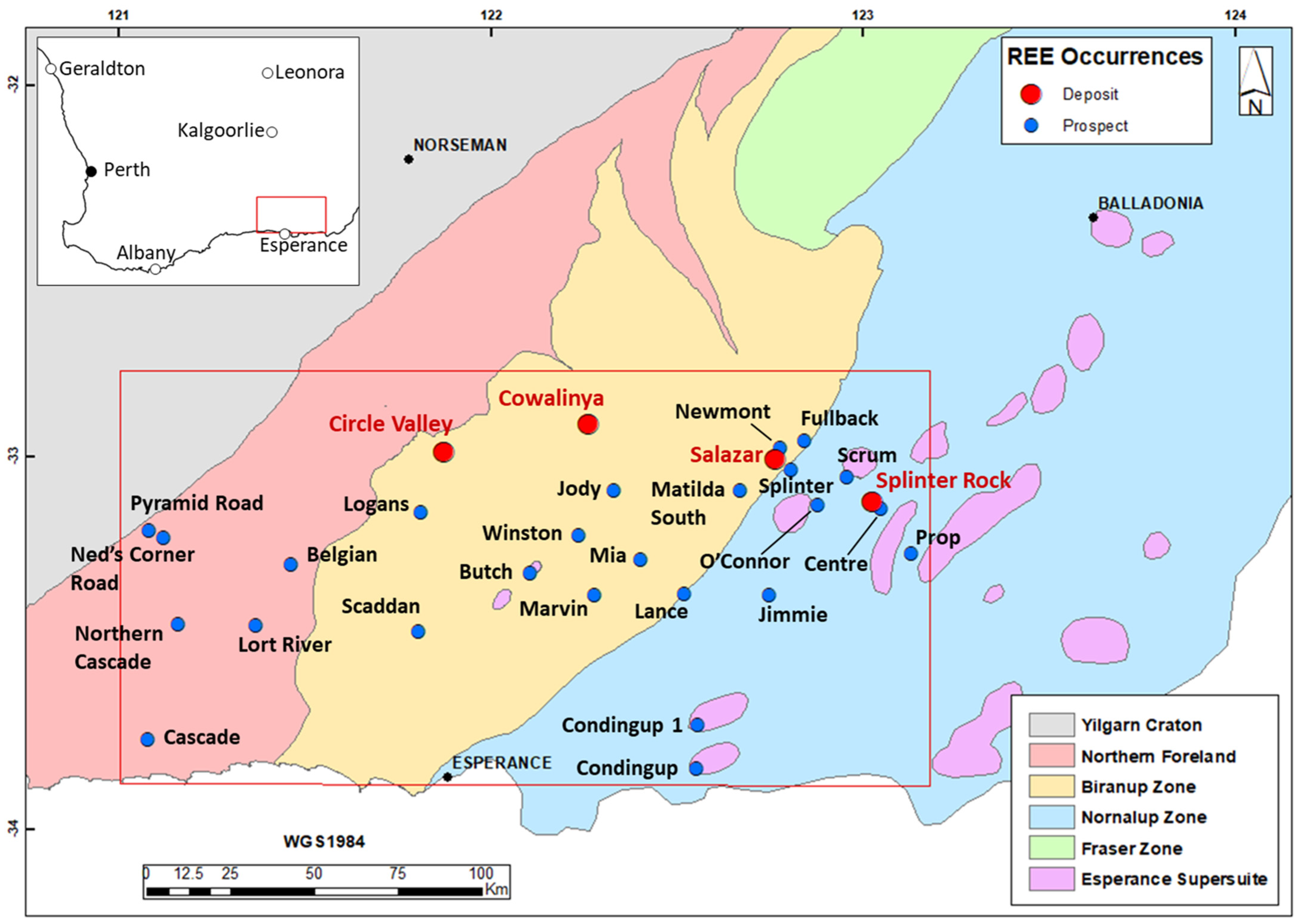
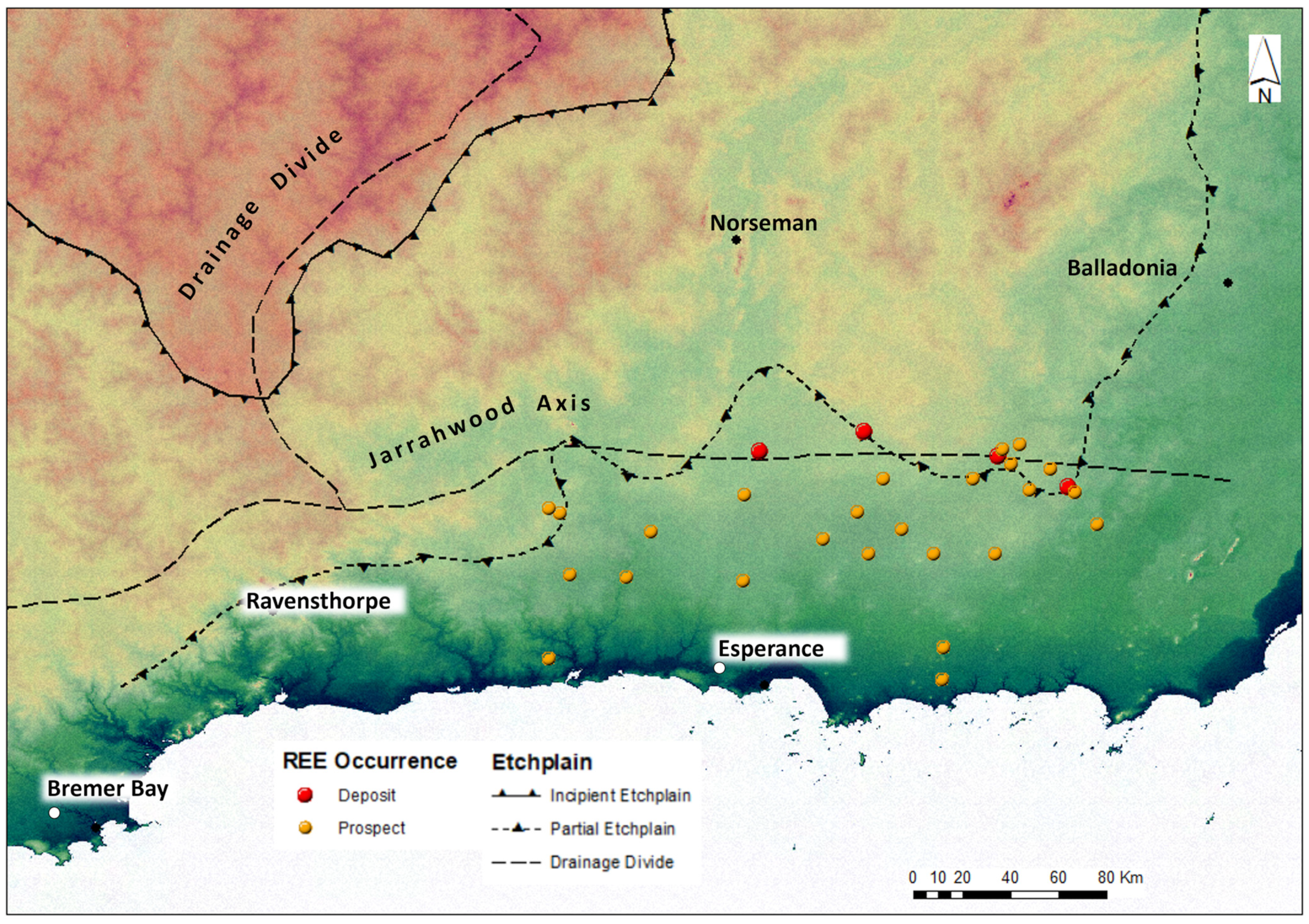
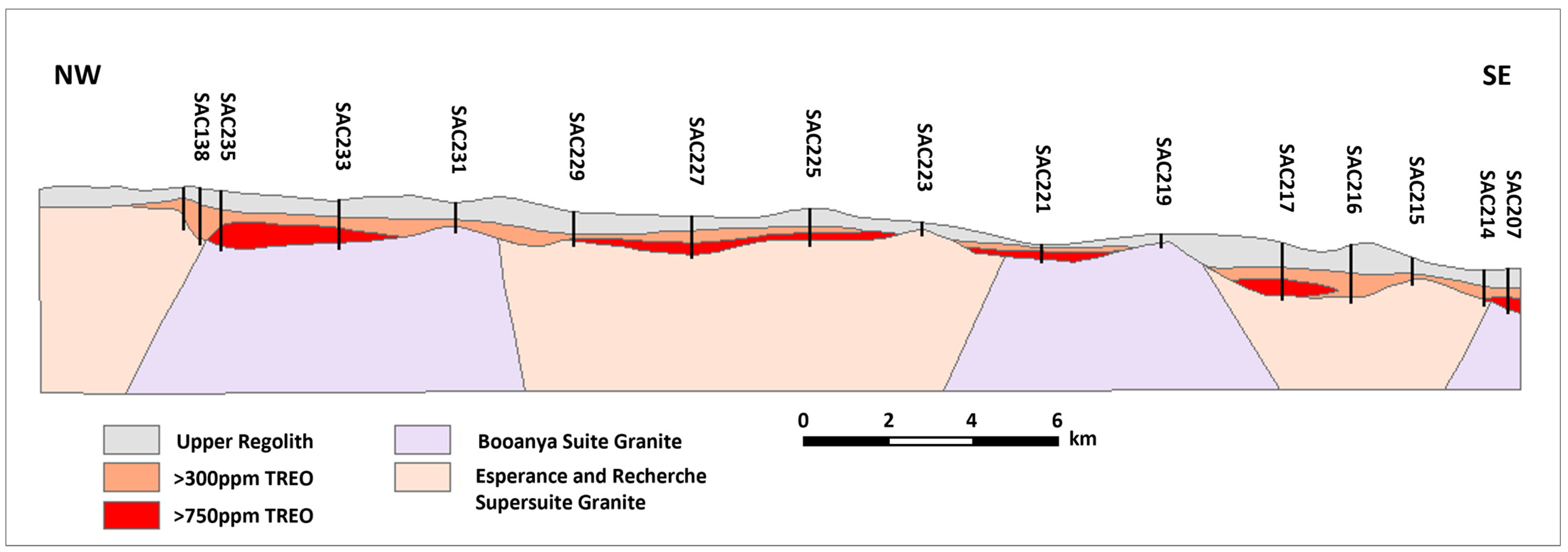
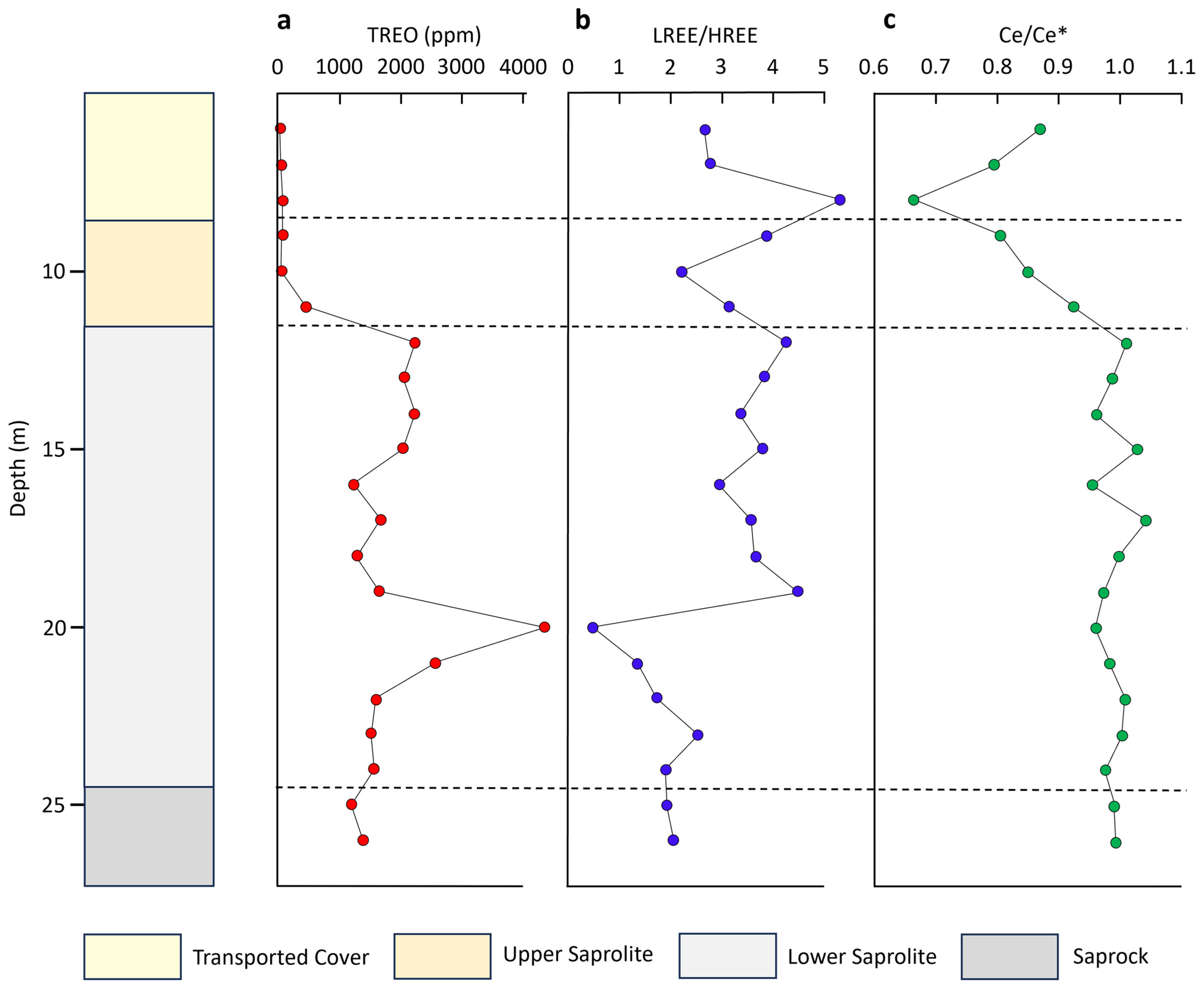
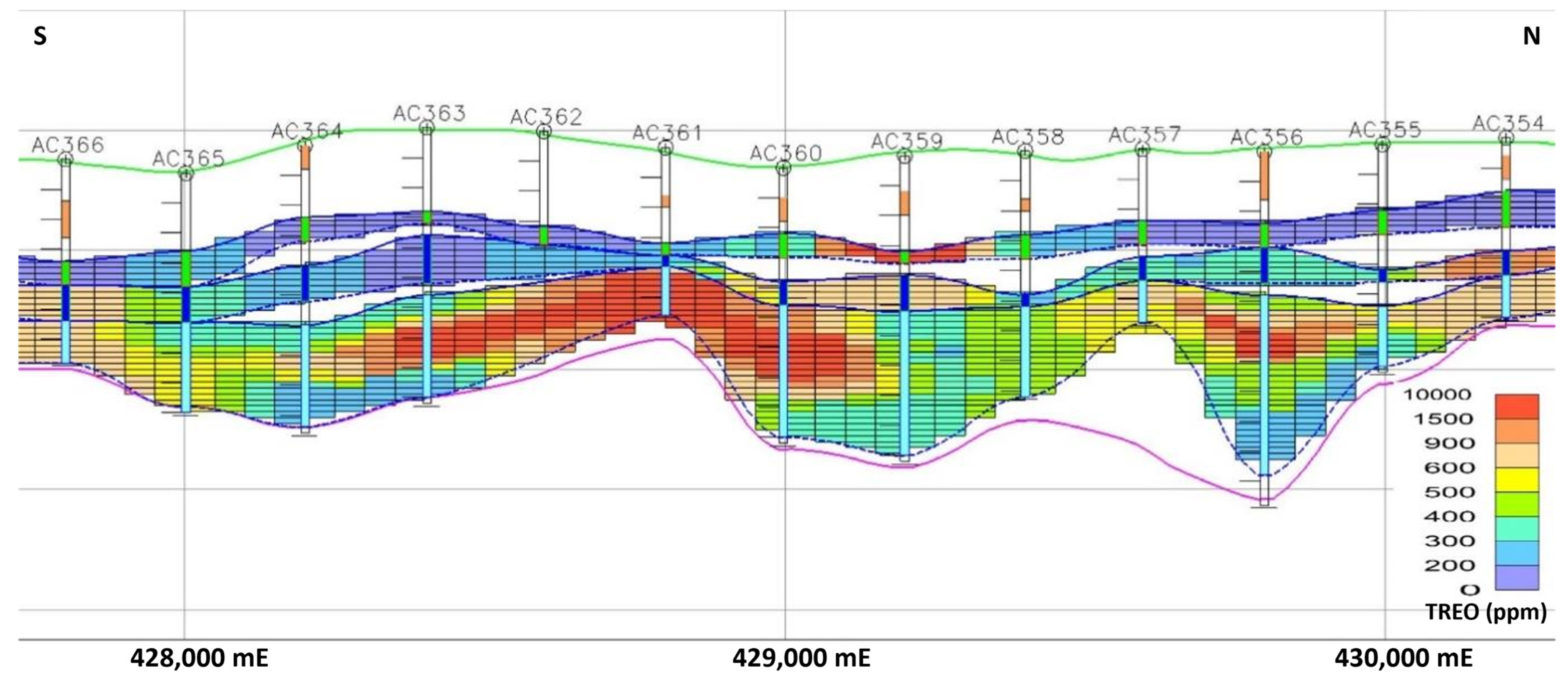

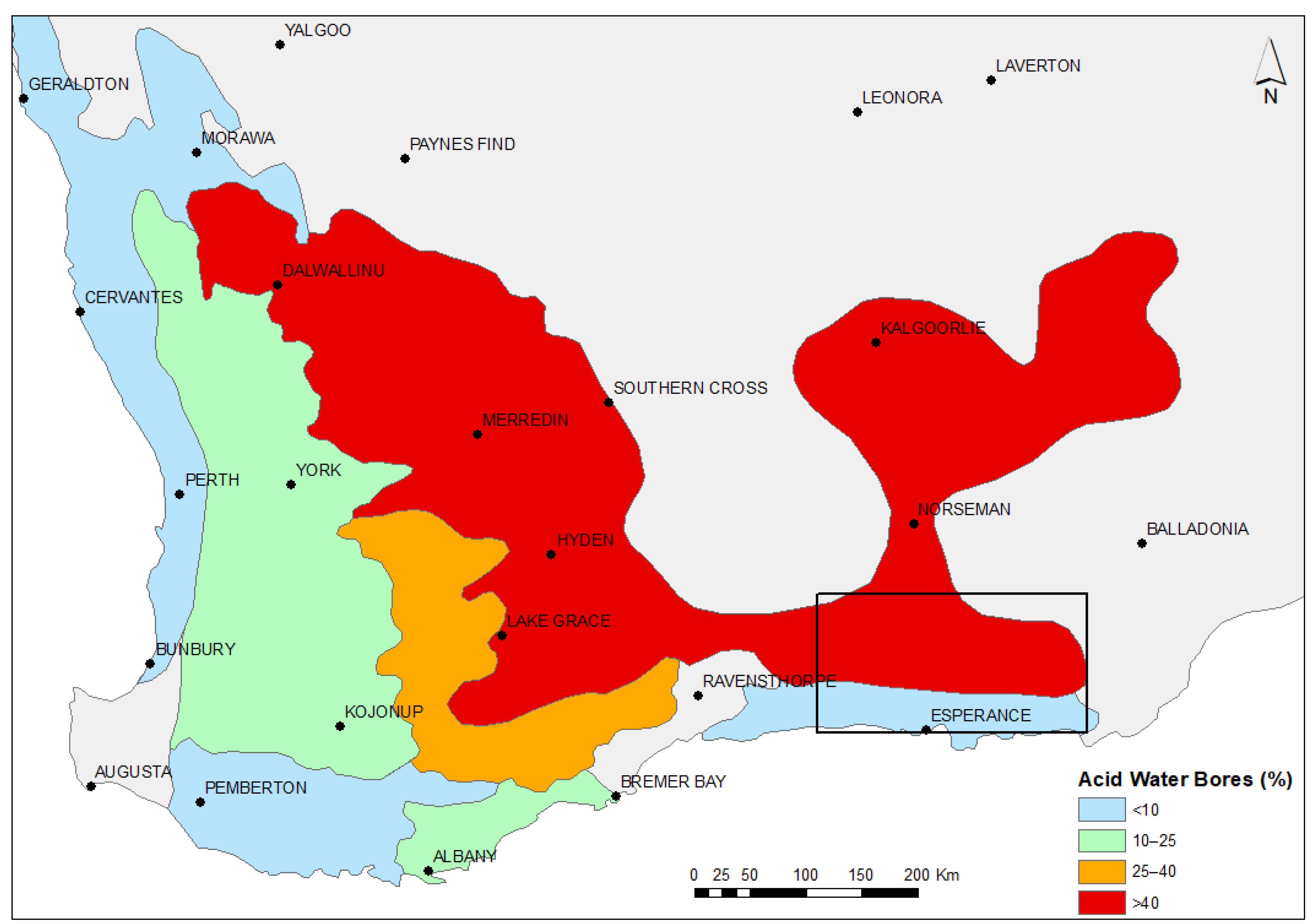

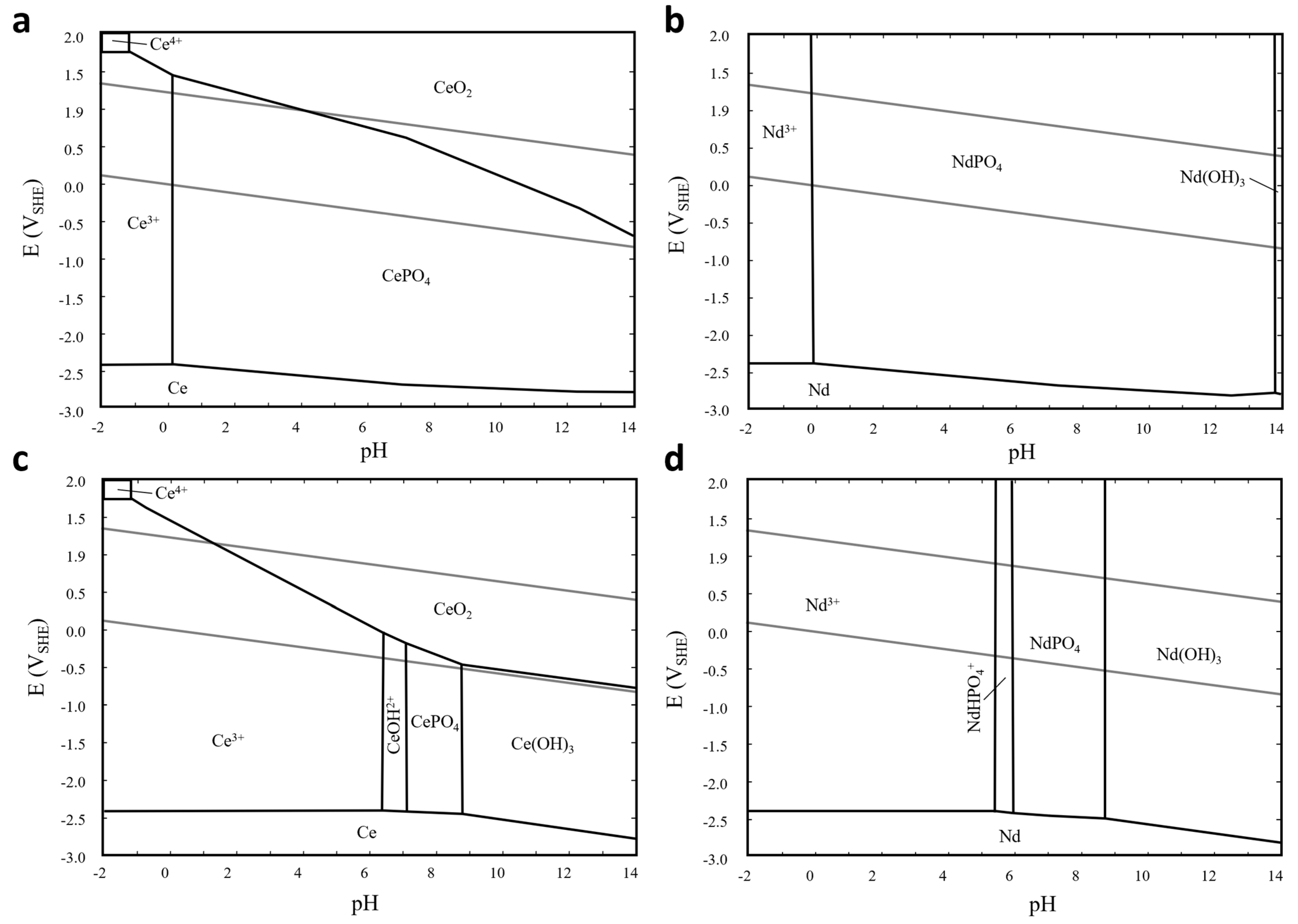
| Deposit | Resource (Mt Ore) | TREO (ppm) | TREO (Kt) | Date | Mining Company | Reference |
|---|---|---|---|---|---|---|
| Cowalinya | 159 | 870 | 138.33 | 3/10/2023 | Heavy Rare Earths Ltd. | [8] |
| Salazar | 190 | 1172 | 222.68 | 9/08/2023 | West Cobar Metals | [9] |
| Splinter Rock | 344 | 1308 | 449.952 | 18/07/2023 | OD6 Metals | [10] |
| Circle Valley | 98 | 890 | 87.22 | 14/06/2023 | Meeka Metals | [11] |
| Extraction Step | Procedure |
|---|---|
| 1. Water soluble and ion exchangeable | To 5 g of sample, add 20 mL of 1.0 M Mg(NO3)2. Shake for 2 h. Centrifuge 15 min at 3000 rpm. Decant supernatant solution and rinse residue with 5 mL H2O twice. Add rinses to supernatant and analyze. |
| 2. Adsorbed and carbonate-bound | To a 1 g derivative from the previous step, add 20 mL of 1.0 M CH3COONa (adjusted to pH 5 using CH3COOH). Shake for 6 h. Centrifuge for 15 min at 3000 rpm. Decant supernatant solution and rinse residue with 5 mL H2O twice. Add rinses to supernatant and analyze. |
| 3. Amorphous Fe oxyhydroxide bound | To the residue from the previous step, add 20 mL of 0.25 M NH2OH·HCl in 0.25 M HCl. Vortex for 5–10 s. Place in a water bath at 60 °C for 2 h. Centrifuge for 15 min at 3000 rpm. Decant supernatant solution and rinse residue with 5 mL H2O twice. Add rinses to supernatant and analyze. |
| 4. Crystalline Fe oxyhydroxide bound | To the residue from the previous step, add 30 mL of 0.25 M NH2OH·HCl in 25% CH3COOH. Cap and vortex for 5–10 s. Place in a water bath at 90 °C for 3 h. Centrifuge for 15 min and decant the supernatant liquid into a labelled test tube. Rinse the residue with 10 mL 25% CH3COOH twice. Add the supernatant rinses to the test tube and analyze solution. |
| 5. Residue—resistive minerals | Rinse residue with MilliQ water and oven dry at 60 °C. Grind to ≤200 μm. Fuse with 12:22 Norrish flux (lithium metaborate/lithium tetraborate). Heat in muffle furnace for 1050 °C for 30 min. Dissolve fusion beads in 100 mL 10% HCl and analyze. |
| Tectonic Zone | Geological Unit | Suite | Age (Ma) | Sample Number | TREO (ppm) | ||
|---|---|---|---|---|---|---|---|
| Minimum | Maximum | Average | |||||
| Biranup Zone | Archean granite | 2634–2684 | 5 | 115 | 229 | 155 | |
| Proterozoic granite | 1660–1800 | 10 | 104 | 330 | 230 | ||
| Northern Foreland | Munglinup Gneiss | 2630–2660 | 8 | 29 | 584 | 246 | |
| Nornalup Zone | Recherche Supersuite | Gora Hill | 1316–1322 | 18 | 166 | 527 | 323 |
| Southern Hills | 1300–1320 | 6 | 183 | 258 | 226 | ||
| Esperance Supersuite | Booanya | 1172 | 9 | 725 | 1090 | 880 | |
| Truslove | 1162–1196 | 4 | 117 | 383 | 251 | ||
| Project | Deposit/Prospect | HCl (g/L) | Temperature (°C) | Duration (h) | Recovery (%) | REE Suite | Reference |
|---|---|---|---|---|---|---|---|
| Cowalinya | Cowalinya South | 100 | 20 | 24 | 27 | TREE | [14] |
| Cowalinya | Cowalinya South | 25 | 30 | 24 | 71 | TREE | [14] |
| Mount Ridley | * | 25 | 20 | 24 | 57 | TREE | [16] |
| Splinter Rock | Centre | 25 | 20 | 6 | 49 | PMREE ** | [17] |
| Splinter Rock | Prop | 25 | 20 | 6 | 68 | PMREE | [17] |
| Salazar | Newmont | 25 | 20 | 8 | 68 | PMREE | [18] |
| Salazar | Newmont | 100 | 20 | 8 | 78 | PMREE | [18] |
| Drill Hole | Depth Range (m) | TREE (ppm) | Relative TREE Proportion by Fraction (%) | ||||
|---|---|---|---|---|---|---|---|
| Water Soluble and Ion-Adsorbed | Adsorbed and Carbonate Bound | Amorphous Fe Oxyhydroxide Bound | Crystalline Fe Oxyhydroxide Bound | Residual Mineral Forms | |||
| SAC021 | 8–10 | 713 | 0.00 | 0.07 | 0.04 | 0.75 | 99.14 |
| 10–14 | 1134 | 0.08 | 0.05 | 0.01 | 1.11 | 98.74 | |
| 14–17 | 1683 | 0.64 | 0.17 | 0.01 | 4.55 | 94.63 | |
| 17–20 | 2474 | 0.50 | 0.37 | 0.03 | 7.09 | 92.01 | |
| 20–24 | 2398 | 0.33 | 0.28 | 0.03 | 3.92 | 95.44 | |
| 24–26 | 2717 | 4.79 | 0.36 | 0.13 | 1.55 | 93.17 | |
| SAC059 | 12–15 | 271 | 0.29 | 0.02 | 0.00 | 0.17 | 99.52 |
| 15–17 | 401 | 0.12 | 0.03 | 0.01 | 0.88 | 98.96 | |
| 17–21 | 400 | 0.15 | 0.04 | 0.00 | 1.43 | 98.38 | |
| 21–26 | 1704 | 0.12 | 0.03 | 0.00 | 1.92 | 97.92 | |
| 26–33 | 2181 | 0.39 | 0.08 | 0.01 | 3.36 | 96.16 | |
| 33–37 | 708 | 1.51 | 0.09 | 0.02 | 1.85 | 96.53 | |
| Depth (m) | pH | REE (ppm) | ||||||||||
|---|---|---|---|---|---|---|---|---|---|---|---|---|
| La | Ce | Pr | Nd | Sm | Eu | Dy | Ho | Er | Y | TREE | ||
| 3 | 6.1 | 5 | bdl | 4 | 5 | bdl | 2 | bdl | bdl | bdl | 5 | 21 |
| 15 | 3.1 | 15 | 50 | 12 | 75 | 25 | 6 | 25 | 6 | 15 | 165 | 394 |
| 30 | 2.8 | 10 | 25 | 6 | 35 | 10 | 4 | 10 | 2 | 5 | 70 | 177 |
Disclaimer/Publisher’s Note: The statements, opinions and data contained in all publications are solely those of the individual author(s) and contributor(s) and not of MDPI and/or the editor(s). MDPI and/or the editor(s) disclaim responsibility for any injury to people or property resulting from any ideas, methods, instructions or products referred to in the content. |
© 2024 by the authors. Licensee MDPI, Basel, Switzerland. This article is an open access article distributed under the terms and conditions of the Creative Commons Attribution (CC BY) license (https://creativecommons.org/licenses/by/4.0/).
Share and Cite
Sergeev, N.; Collins, T. Regolith-Hosted Rare Earth Element Mineralization in the Esperance Region, Western Australia: Major Characteristics and Potential Controls. Minerals 2024, 14, 847. https://doi.org/10.3390/min14080847
Sergeev N, Collins T. Regolith-Hosted Rare Earth Element Mineralization in the Esperance Region, Western Australia: Major Characteristics and Potential Controls. Minerals. 2024; 14(8):847. https://doi.org/10.3390/min14080847
Chicago/Turabian StyleSergeev, Nikita, and Tiffany Collins. 2024. "Regolith-Hosted Rare Earth Element Mineralization in the Esperance Region, Western Australia: Major Characteristics and Potential Controls" Minerals 14, no. 8: 847. https://doi.org/10.3390/min14080847





